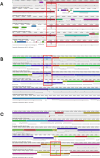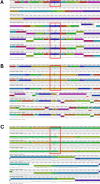Characterization of toxin systems of Paenibacillus strains isolated from honeybees
- PMID: 40858718
- PMCID: PMC12381145
- DOI: 10.1038/s41598-025-12956-x
Characterization of toxin systems of Paenibacillus strains isolated from honeybees
Abstract
Paenibacillus is a large genus of Gram-positive bacteria isolated from a wide range of sources. Members of this genus have attracted significant research as plant growth promoters as well as pathogens of both plants and animals. Extensive studies have been conducted on Paenibacillus larvae, the causative agent of American Foul Brood in honeybees, but little is known about other closely related species associated with honeybees, such as Paenibacillus apiarius or Paenibacillus thiaminolyticus. These bacterial species have been isolated from dead honeybee larvae and are believed to be secondary invaders as opposed to primary pathogens. We utilized genome mining efforts to explore the number and diversity of toxins present in multiple species of Paenibacillus, with major emphasis on a potentially entomopathogenic clade that includes Paenibacillus alvei, P. apiarius, and P. thiaminolyticus. Our results show that strains of these species contain a variety of potentially insecticidal toxins, including highly conserved Spp-like and Mpp-like toxins. These toxins are absent in P. larvae. We also found several ADP-ribosylases which were shared between P. larvae and several strains from this entomopathogenic clade. Tc toxins, a class of insecticidal toxin not often found in Gram-positive bacteria were found in in P. apiarius and P. alvei. These findings suggest the potential for Paenibacillus species in this clade to be harnessed as sources of host specific and pollinator-friendly biopesticides.
© 2025. This is a U.S. Government work and not under copyright protection in the US; foreign copyright protection may apply.
Conflict of interest statement
Declarations. Competing interests: The authors declare no competing interests.
Figures






Similar articles
-
Honey-derived Paenibacillus spp. with potential to affect bee brood development in Apis mellifera: Are they a new threat to honey bees?Virulence. 2025 Dec;16(1):2451170. doi: 10.1080/21505594.2025.2451170. Epub 2025 Feb 15. Virulence. 2025. PMID: 39954288 Free PMC article.
-
Prescription of Controlled Substances: Benefits and Risks.2025 Jul 6. In: StatPearls [Internet]. Treasure Island (FL): StatPearls Publishing; 2025 Jan–. 2025 Jul 6. In: StatPearls [Internet]. Treasure Island (FL): StatPearls Publishing; 2025 Jan–. PMID: 30726003 Free Books & Documents.
-
Gallic acid enhances honeybee larvae resistance to Paenibacillus larvae infections: Insights from molecular docking, bacterial community modulation, and whole-genome sequencing.Insect Sci. 2025 Aug;32(4):1380-1402. doi: 10.1111/1744-7917.70000. Epub 2025 Feb 25. Insect Sci. 2025. PMID: 40000891
-
Systemic pharmacological treatments for chronic plaque psoriasis: a network meta-analysis.Cochrane Database Syst Rev. 2020 Jan 9;1(1):CD011535. doi: 10.1002/14651858.CD011535.pub3. Cochrane Database Syst Rev. 2020. Update in: Cochrane Database Syst Rev. 2021 Apr 19;4:CD011535. doi: 10.1002/14651858.CD011535.pub4. PMID: 31917873 Free PMC article. Updated.
-
Systemic pharmacological treatments for chronic plaque psoriasis: a network meta-analysis.Cochrane Database Syst Rev. 2021 Apr 19;4(4):CD011535. doi: 10.1002/14651858.CD011535.pub4. Cochrane Database Syst Rev. 2021. Update in: Cochrane Database Syst Rev. 2022 May 23;5:CD011535. doi: 10.1002/14651858.CD011535.pub5. PMID: 33871055 Free PMC article. Updated.
References
MeSH terms
Substances
Grants and funding
LinkOut - more resources
Full Text Sources
Miscellaneous

